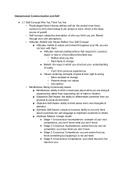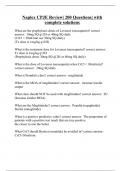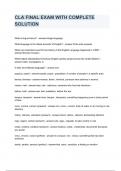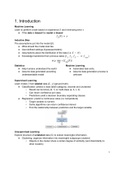, MODULE I
ELECTROCHEMISTRY AND CORROSION
The branch of chemistry which deals with two forms of energy such as electrical energy
and chemical energy and the inter-conversion of one form to another is called electrochemistry.
Thus there are two types of electro chemical changes. On the basis of electrochemical changes,
cells are of two types.
1. Electrolytic cell
2. Galvanic cell (Voltaic cell) (Electro chemical cell)
Differences between electrolytic cell & galvanic cell
Electrolytic cell Electro chemical cell
It is used for the conversion of electrical It is used for the conversion of chemical
energy to chemical energy. energy to electrical energy.
It requires EMF. It produces EMF.
Anode is +ve and cathode is –ve. Anode is –ve and cathode is +ve.
Discharges of ions occur at both the Discharges of ions occur only at cathode.
electrodes.
Non-spontaneous reaction occurs. Spontaneous reaction occurs.
These are irreversible. These may be reversible.
Comparison of electrolytic cell & galvanic cell
Electrolytic cell Electro chemical cell
Oxidation takes place at the anode and Oxidation takes place at the anode and
reduction at the cathode. reduction at the cathode.
Flow of electrons from anode to cathode. Flow of electrons from anode to cathode.
Electrons leave the cell at anode and enter Electrons leave the cell at anode and enter
the cell at cathode. the cell at cathode.
Electrode potential and its origin
When a metal rod is immersed in a solution of its own ion, it will either undergo
oxidation or reduction. As a result metal rod attains positive or negative charge. If the metal rod
attains the positive charge, then it can attract the negatively charged free ions from the solution
& if the metal rod attains negative charge, then it can attract the positively charged free ions from
the solution. As a result a layer of both positive and negative charge is produced on the metal
rod. This will lead to the development of a potential and is called electrode potential.
Electrode potential (E) is defined as the tendency of an electrode to lose or gain
electrons when it is immersed in a solution of its own ions. Electrode potential is of two types.
They are
1. Oxidation potential
2. Reduction potential
Oxidation potential
It is defined as the tendency of an electrode to lose electrons when it is immersed in a
solution of its own ions.
Reduction potential
It is defined as the tendency of an electrode to gain electrons when it is immersed in a
solution of its own ions.
Sree Buddha college of Engineering, Pattoor Page 1
, Electrode potential becomes constant at equilibrium then it is called standard
electrode potential (E0). It is defined as the tendency of an electrode to lose or gain electrons
when it is immersed in a solution of its own ions of 1M concentration, 1atm pressure and 298K
or 25ºC.
It is not possible to find out the absolute value of electrode potential, since neither oxidation nor
reduction takes place independently both occur simultaneously. Hence we can find out the
relative value of electrode potential by coupling it with universally accepted reference electrode
such as SHE or NHE. Its potential is arbitrarily fixed as zero. It can function as an anode or
cathode depending on the nature of the other electrode to which it is connected.
In order to measure the standard electrode potential of Zn rod, (Zn rod dipped in 1M ZnSO 4
solution) Zn electrode is coupled with SHE internally using salt bridge and externally using volt
meter. Zn has greater tendency for oxidation than SHE. So Zn can function as anode and SHE
can function as the cathode. The resultant cell potential can be read directly from the volt meter.
The resultant cell can be represented in the following manner,
Zn/Zn2+//H+(1M)/H2(1atm)/Pt
E0 Cell = E0cathode – E0anode
= E0 SHE-E0Zn/Zn2+
0.76 V = 0 - E0 Zn/Zn2+
(E0Zn/Zn2+= -0.76V)
Helmholtz electrical double layer
When an electrode is immersed in a solution of its own ions an electrical double layer is
produced. It is the double layer of both positive and negative charges. Electrical double layer
corresponds to an electrical capacitor. Electrical properties can be explained qualitatively by
using the concept of electrical double layer at the solid liquid interphase. This concept was
proposed by the scientist, Helmholtz. He considered that electrical double layer is produced at
the surface of separation between the two phases, i.e. the solid electrode and liquid electrolyte.
Electrical double layer consists of two parts.
1). Fixed part 2) Diffused part
Fixed part: It is fixed to the solid electrode. It contains either positive or negative ions.
Diffused part: It extends some distance into the solution. It contains both positive and negative
ions. The existence of charges of opposite signs on the diffused to the fixed part of the electrical
double layer develops a potential between the two layers. This potential is called electro kinetic
potential or zeta potential.
Sree Buddha college of Engineering, Pattoor Page 2
ELECTROCHEMISTRY AND CORROSION
The branch of chemistry which deals with two forms of energy such as electrical energy
and chemical energy and the inter-conversion of one form to another is called electrochemistry.
Thus there are two types of electro chemical changes. On the basis of electrochemical changes,
cells are of two types.
1. Electrolytic cell
2. Galvanic cell (Voltaic cell) (Electro chemical cell)
Differences between electrolytic cell & galvanic cell
Electrolytic cell Electro chemical cell
It is used for the conversion of electrical It is used for the conversion of chemical
energy to chemical energy. energy to electrical energy.
It requires EMF. It produces EMF.
Anode is +ve and cathode is –ve. Anode is –ve and cathode is +ve.
Discharges of ions occur at both the Discharges of ions occur only at cathode.
electrodes.
Non-spontaneous reaction occurs. Spontaneous reaction occurs.
These are irreversible. These may be reversible.
Comparison of electrolytic cell & galvanic cell
Electrolytic cell Electro chemical cell
Oxidation takes place at the anode and Oxidation takes place at the anode and
reduction at the cathode. reduction at the cathode.
Flow of electrons from anode to cathode. Flow of electrons from anode to cathode.
Electrons leave the cell at anode and enter Electrons leave the cell at anode and enter
the cell at cathode. the cell at cathode.
Electrode potential and its origin
When a metal rod is immersed in a solution of its own ion, it will either undergo
oxidation or reduction. As a result metal rod attains positive or negative charge. If the metal rod
attains the positive charge, then it can attract the negatively charged free ions from the solution
& if the metal rod attains negative charge, then it can attract the positively charged free ions from
the solution. As a result a layer of both positive and negative charge is produced on the metal
rod. This will lead to the development of a potential and is called electrode potential.
Electrode potential (E) is defined as the tendency of an electrode to lose or gain
electrons when it is immersed in a solution of its own ions. Electrode potential is of two types.
They are
1. Oxidation potential
2. Reduction potential
Oxidation potential
It is defined as the tendency of an electrode to lose electrons when it is immersed in a
solution of its own ions.
Reduction potential
It is defined as the tendency of an electrode to gain electrons when it is immersed in a
solution of its own ions.
Sree Buddha college of Engineering, Pattoor Page 1
, Electrode potential becomes constant at equilibrium then it is called standard
electrode potential (E0). It is defined as the tendency of an electrode to lose or gain electrons
when it is immersed in a solution of its own ions of 1M concentration, 1atm pressure and 298K
or 25ºC.
It is not possible to find out the absolute value of electrode potential, since neither oxidation nor
reduction takes place independently both occur simultaneously. Hence we can find out the
relative value of electrode potential by coupling it with universally accepted reference electrode
such as SHE or NHE. Its potential is arbitrarily fixed as zero. It can function as an anode or
cathode depending on the nature of the other electrode to which it is connected.
In order to measure the standard electrode potential of Zn rod, (Zn rod dipped in 1M ZnSO 4
solution) Zn electrode is coupled with SHE internally using salt bridge and externally using volt
meter. Zn has greater tendency for oxidation than SHE. So Zn can function as anode and SHE
can function as the cathode. The resultant cell potential can be read directly from the volt meter.
The resultant cell can be represented in the following manner,
Zn/Zn2+//H+(1M)/H2(1atm)/Pt
E0 Cell = E0cathode – E0anode
= E0 SHE-E0Zn/Zn2+
0.76 V = 0 - E0 Zn/Zn2+
(E0Zn/Zn2+= -0.76V)
Helmholtz electrical double layer
When an electrode is immersed in a solution of its own ions an electrical double layer is
produced. It is the double layer of both positive and negative charges. Electrical double layer
corresponds to an electrical capacitor. Electrical properties can be explained qualitatively by
using the concept of electrical double layer at the solid liquid interphase. This concept was
proposed by the scientist, Helmholtz. He considered that electrical double layer is produced at
the surface of separation between the two phases, i.e. the solid electrode and liquid electrolyte.
Electrical double layer consists of two parts.
1). Fixed part 2) Diffused part
Fixed part: It is fixed to the solid electrode. It contains either positive or negative ions.
Diffused part: It extends some distance into the solution. It contains both positive and negative
ions. The existence of charges of opposite signs on the diffused to the fixed part of the electrical
double layer develops a potential between the two layers. This potential is called electro kinetic
potential or zeta potential.
Sree Buddha college of Engineering, Pattoor Page 2











